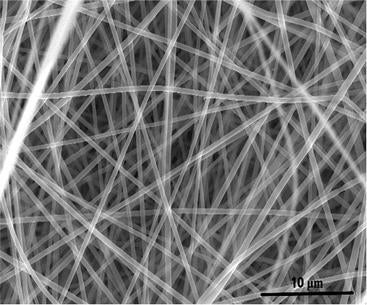(Upcycling plastic waste toward sustainable energy storage)
2020/8/11 アメリカ合衆国・カリフォルニア大学リバーサイド校(UCR)

アップサイクルされたペットボトルから作られたエネルギー貯蔵用材料の走査型電子顕微鏡画像。
(Mihri Ozkan & Cengiz Ozkan/UCR)
・ UCR が、廃棄プラスチックをエネルギー貯蔵ナノ材料に転換する技術を開発。
・ UCR では、ガラス瓶や海砂等のサステナブルな原料からエネルギー貯蔵材料を作製する研究を続けている。今回の結果は、プラスチックによる環境汚染の低減と 100%クリーンエネルギーへの移行を促進するものと考える。
・ 世界の車輌の 30%が 2040 年までに電動化することが予想され、高コストの電池原料が課題に。廃棄物利用とプラスチックボトルのアップサイクリングにより、プラスチック由来の世界の環境汚染の解消に加え、持続可能性を維持して電池を製造しながら電池の総コストの低減が期待できる。
・ 今回開発した技術は、飲料水等で使用されるポリエチレンテレフタレート(PET)の廃棄プラスチックを多孔質のナノ炭素材料に転換する、持続可能でシンプルなアップサイクリングプロセス。
・ PET プラスチックボトルを粉砕して溶解し、電子スピニングプロセスでポリマーの微細なファイバーを作製して炉にて炭化。バインダと導電剤の混合後乾燥させ、ボタン型電池の電気二重層スーパーキャパシタを作製した。
・ スーパーキャパシタでの試験結果では、イオンと電荷の配列で形成される二重層キャパシタと、イオンが電気化学的に材料表面に吸収されて起こるレドックス反応疑似容量の両特性を確認。
・ リチウムイオン電池のようなエネルギー貯蔵容量は無いが、より速く充電できるため、多様なアプリケーションでの利用が可能。電子スピンによるファイバーを炭化前にホウ素、窒素やリン等でドープすることで、電気特性の向上を図る。
・ 環境と経済での優位性をを有する同アップサイクル技術のプロセスは、スケーラブルで市場性を備えた、埋立地や海洋への PET 廃棄回避に向けた大きな進展と考える。
URL: https://news.ucr.edu/articles/2020/08/11/upcycling-plastic-waste-toward-sustainable-energy-storage
<NEDO海外技術情報より>
(関連情報)
Energy Storage 掲載論文(アブストラクトのみ:全文は有料)
Upcycling of Polyethylene Terephthalate Plastic Waste to Microporous Carbon Structure for Energy
Storage
URL: https://onlinelibrary.wiley.com/doi/abs/10.1002/est2.201
Abstract
Plastic pollution and its harmful effects on the earth ecosystem, which inevitably affect quality of life, have brought attention to the frontiers of research society. Among plastics, polyethylene terephthalate (PET) is used on a massive scale in various sectors of industry, including the automobile, textile, and packaging. Utilizing an electrospinning fiber production technique, we have successfully upcycled PET waste bottle into electrochemical active carbon material that functions as a double‐layer supercapacitor substance. Our detailed electrochemical and analytical characterization revealed that the generated carbon substance is a mixture of amorphous carbon and reduced graphene oxide with relatively high surface area. The electrochemical characterization of the as‐prepared material consisting of cyclic voltammetry, galvanostatic cycling with potential limitations, and electrochemical impedance spectroscopy analyses revealed that the generated medium has combined characteristics of both double‐layer and redox reaction pseudo‐capacitance with self‐strengthening effect along cycling. We believe that the proposed process is scalable with environmental and economic advantages and this study could present opportunities for future research and development.



